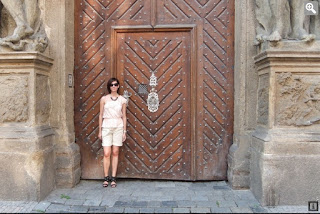It is easier and more satisfactory to use one's own images and photos instead of steling them from the web and risking troubles.
A teacher should be able to:
- draw a picture, scan, save and publish
- make a good photo which he/she can use in teaching, edit and save
The difference between good and bad photos is obvious to anyone! And it is not so difficult to follow several basic rules to make your photos better.
"Kreativní fotografie si neklade za cíl zobrazit realitu (takové to tam Mařenko bylo) ale zobrazit
něco víc. Zobrazit emoce (pocity, nálady ...), které autor na místě cítil a chce vám předat.
A teacher should be able to:
- draw a picture, scan, save and publish
- make a good photo which he/she can use in teaching, edit and save
The difference between good and bad photos is obvious to anyone! And it is not so difficult to follow several basic rules to make your photos better.
"Kreativní fotografie si neklade za cíl zobrazit realitu (takové to tam Mařenko bylo) ale zobrazit
něco víc. Zobrazit emoce (pocity, nálady ...), které autor na místě cítil a chce vám předat.
Když se díváte na fotografie z vaší dovolené obvykle si vybavíte pocity, jaké to tam bylo (jé podívej - tady jsme byli ...). Díváte-li se ale na fotografie z cizí dovolené, vidíte jenom obyčejné pláže, hrady, zámky atp. Prostě emoce spojené s místem a zážitkem vám chybí a proto vám často tyto fotografie připadají obyčejné. Dobrá fotografie vám dokáže předat pocity a zážitky i z míst, kde jste nebyli. A o tom to je...
Když stojíte v lese, vidíte široko okolo sebe, vnímáte vítr, šumění lesa, vůni jehličí a do zad vás pálí slunce. Toto vše na fotografii však chybí. Je tam jen obrazový výsek a to ještě ve 2 rozměrech (3 rozměr prostoru / perspektivy chybí). A proto je to tak těžké. A proto je pokoušet se o to taky tak krásné!"
TASK 1
Look at the following photos. Do you like them? Why?
What shall we know?
1. How to compose a photography
Practical composition (in Czech)
Do not forget:
concentrate on a single idea, object, feeling
get closer, fill almost the whole field with the target object/situation
TASK 2 (20 minutes)
Look around, go to the corridor if you want. Try to compose a photo which will show the atmosphere at school.
Continue thinking about this task, and make more pictures in the following weeks. Choose the best one to e presented in your webpage.
_________________________________________________________________
What shall we know?
2. How to save an image
raw - full data
jpg - compressed (lossy)
tiff - for print, usually lossless; can handle CMYK
bmp - full data (bitmap)
gif - small (and animated); saves only used colours; 8bit
png - lossless, successor of gif, 8-24-48 bit
psd - photoshop format
For web, an image with the longer side of 1600px is big enough, Let's say the size limit is cca 50KB - to save space.
When reducing the size, always keep the original untouched! Save the small version as a new file, say, IMG2345_Small.jpg.
JPEGS reduce the size exponetially, so if you reduce the original at 80%, the amount of data may be reduced form 12MB to 1,5 MB.
Repeatedly saving of jpeg means repeating the compressing process and losing data!
More in Wiki (in Czech)
and Wiki (in English)
_________________________________________________________________
TASK 3
Choose an object within the class and make a picture which shows only the object - as if you needed an illustration of the word. (A key, a pen, an apple, a watch...)
Try to make your own photos of the objects you need for the HotPot project.
What shall we know?
3. How to make a photo of an isolated object
- check the background
- fill amost the whole image with the object
- search for light
- use simple aids, such as lamps, scarfs, sheets of paper
- experiment
Product Photography at digineff
_________________________________________________________________
... want to know more? (In Czech)
HOMEWORK:




Žádné komentáře:
Okomentovat